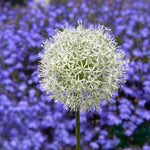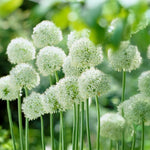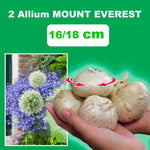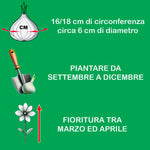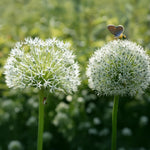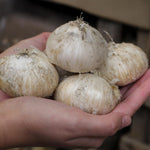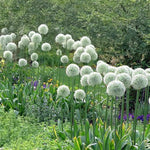-
Description
DESCRIPTION: Allium 'Mount Everest' 🌿 is an exceptionally elegant and architectural ornamental onion, cherished for its tall, statuesque form and pristine white spherical blooms. Named after the world’s highest peak, it lives up to its name with an impressive height of around 100 to 120 centimetres, making it one of the tallest white alliums in cultivation. Its flower heads, perfectly round and about 12 to 15 centimetres in diameter, are composed of hundreds of tiny star-shaped flowers in pure snow white 🤍, creating a light, airy effect that adds height and brightness to any garden composition without overwhelming the space visually. This variety thrives best in full sun ☀️, where it can develop strong, upright stems and vibrant flower heads. Though it can tolerate partial shade, full exposure ensures the most vigorous growth and abundant flowering. ‘Mount Everest’ typically blooms from late May to early June 🌼, just after most spring bulbs have faded and before summer perennials reach their peak, offering a graceful bridge between seasons. While it can be grown from seed, germination is slow and requires stratification, so it is far more common—and much easier—to grow it from bulbs planted in the autumn months. The foliage, a soft glaucous green, forms a basal clump of strap-shaped leaves that may begin to fade as flowering begins. Because of its vertical elegance and clean color, ‘Mount Everest’ combines beautifully with a range of plants such as lavender, catmint, peonies, and ornamental grasses, and is also a favourite among designers for modern borders and monochrome palettes. Its blooms last up to three or four weeks and dry well, retaining their shape and structure, even when the colour fades. This allium is not only deer- and rabbit-resistant 🐇🦌, but also beloved by pollinators, bringing both beauty and ecological value to the garden.
STRIKING FEATURES: The inflorescence is spherical, with a diameter of about 12–15 cm, composed of hundreds of small, star-shaped flowers in a pure snow-white color. The flowers are dense and harmonious, with a very regular shape. Flowering occurs from late May to early June. The stem is tall, upright, and very sturdy, reaching an overall height of around 100–120 cm. It is ideal for adding vertical structure to the garden without creating visual heaviness. The leaves are glaucous green and strap-shaped.
HOW TO GROW: Exposure: It prefers full sun ☀️ but can tolerate partial shade if the soil is well-drained. Soil: Light, sandy, and well-drained. It does not tolerate waterlogging — in heavy soils, it is advisable to add sand or gravel to improve drainage. Planting: In autumn, between September and December. Depth: around 15–20 cm. Spacing: at least 20–25 cm between bulbs. Hardiness: This is a perennial plant that is highly cold-hardy (down to -25 °C ❄️). The bulbs can remain in the ground and will naturalize over time.
USAGE: Excellent when planted in groups of five or more for a striking visual effect. It is ideal as a structural plant in mixed borders and pairs beautifully with Nepeta (catmint), lavender, Salvia nemorosa, Pennisetum (ornamental grasses), peonies, and irises. It also performs very well as a cut flower, with a vase life of up to two weeks, and is often used in modern floral arrangements.
PACKAGE: The package contains 2 bulbs of Allium ‘Mount Everest’. The bulbs have a circumference of 16/18 cm (about 6 cm in diameter). The packaging features a beautiful illustrative photo and includes planting and flowering information, making it an excellent gift idea.
SELECTION AND QUALITY: The bulbs come with a phytosanitary passport and undergo a strict quality control process to ensure splendid blooms from the first year.
AFTER-SALES ASSISTANCE: Customer satisfaction is our top priority. We are available to assist you with any questions or concerns regarding your purchase. You can contact us via the Amazon messaging platform or our dedicated WhatsApp line.








